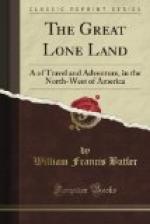So much for the rivers; and now for the land through which they flow. How shall we picture it? How shall we tell the story of that great, boundless, solitary waste of verdure?
The old, old maps which the navigators of the sixteenth century framed from the discoveries of Cabot and Cartier, of Varrazanno and Hudson, played strange pranks with the geography of the New World. The coast-line, with the estuaries of large rivers, was tolerably accurate; but the centre of America was represented as a vast inland sea whose shores stretched far into the Polar North; a sea through which lay the much-coveted passage to the long sought treasures of the old realms of Cathay. Well, the geographers of that period erred only in the description of ocean which they placed in the central continent, for an ocean there is, and an ocean through which men seek the treasures of Cathay, even in our own times. But the ocean is one of grass, and the shores are the crests of mountain ranges, and the dark pine forests of sub-Arctic regions. The great ocean itself does not present more infinite variety than does this prairie-ocean of which we speak. In winter, a dazzling surface-of purest snow; in early summer, a vast expanse of grass and pale pink roses; in autumn too often a-wild sea of raging-fire. No ocean of water in the world can vie with its gorgeous sunsets;—no solitude can equal the loneliness of a night-shadowed prairie: one feels the stillness, and hears the silence, the wail of the prowling wolf makes the voice of solitude audible, the stars look down through infinite silence upon a silence almost as intense. This ocean has no past—time has been nought to it; and men have come and gone, leaving behind them no track, no vestige, of their presence. Some French writer, speaking of these prairies, has said that the sense of this utter negation of life, this complete absence of history, has struck him with a loneliness oppressive and sometimes terrible in its intensity. Perhaps so; but, for my part, the prairies had nothing terrible in their aspect, nothing oppressive in their loneliness. One saw here the world as it had taken shape and form from the hands of the Creator. Nor did the scene look less beautiful because nature alone tilled the earth, and the unaided sun brought forth the flowers.




